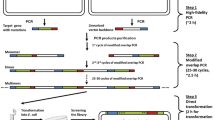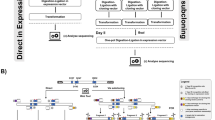Abstract
Objectives
To improve the quality of mutagenesis libraries in directed evolution strategy.
Results
In the process of library transformation, transformants which have been shown to take up more than one plasmid might constitute more than 20% of the constructed library, thereby extensively impairing the quality of the library. We propose a practical transformation method to prevent the occurrence of multiple-plasmid transformants while maintaining high transformation efficiency. A visual library model containing plasmids expressing different fluorescent proteins was used. Multiple-plasmid transformants can be reduced through optimizing plasmid DNA amount used for transformation based on the positive correlation between the occurrence frequency of multiple-plasmid transformants and the logarithmic ratio of plasmid molecules to competent cells.
Conclusions
This method provides a simple solution for a seemingly common but often neglected problem, and should be valuable for improving the quality of mutagenesis libraries to enhance the efficiency of directed evolution strategies.


Similar content being viewed by others
References
Aune TEV, Aachmann FL (2010) Methodologies to increase the transformation efficiencies and the range of bacteria that can be transformed. Appl Microbiol Biotechnol 85:1301–1313
Bjarnason J, Southward CM, Surette MG (2003) Genomic profiling of iron-responsive genes in Salmonella enterica serovar typhimurium by high-throughput screening of a random promoter library. J Bacteriol 185:4973–4982
Bornscheuer UT, Pohl M (2001) Improved biocatalysts by directed evolution and rational protein design. Curr Opin Chem Biol 5:137–143
Casadaban MJ, Cohen SN (1980) Analysis of gene control signals by DNA fusion and cloning in Escherichia coli. J Mol Biol 138:179–207
Chartrain M, Salmon PM, Robinson DK, Buckland BC (2000) Metabolic engineering and directed evolution for the production of pharmaceuticals. Curr Opin Biotechnol 11:209–214
Chen W et al (2015) Design of an ectoine-responsive AraC mutant and its application in metabolic engineering of ectoine biosynthesis. Metab Eng 30:149–155
Chung CT, Niemela SL, Miller RH (1989) One-step preparation of competent Escherichia coli—transformation and storage of bacterial cells in the same solution. Proc Natl Acad Sci USA 86:2172–2175
Davis JH, Rubin AJ, Sauer RT (2011) Design, construction and characterization of a set of insulated bacterial promoters. Nucleic Acids Res 39:1131–1141
Davison J (1984) Mechanism of control of DNA-replication and incompatibility in ColE1-type plasmids—a review. Gene 28:1–15
Gems DH, Clutterbuck AJ (1993) Co-transformation with autonomously-replicating helper plasmids facilitates gene cloning from an Aspergillus nidulans gene library. Curr Genet 24:520
Iwasaki K, Uchiyama H, Yagi O, Kurabayashi T, Ishizuka K, Takamura Y (1994) Transformation of Pseudomonas putida by electroporation. Biosci Biotechnol Biochem 58:851–854
Jackel C, Kast P, Hilvert D (2008) Protein design by directed evolution. Annu Rev Biophys 37:153–173
Kawata Y, Yano S, Kojima H, Toyomizu M (2004) Transformation of Spirulina platensis strain C1 (Arthrospira sp. PCC9438) with Tn5 transposase–transposon DNA–cation liposome complex. Mar Biotechnol 6:355–363
Liang CN, Xiong DD, Zhang Y, Mu SS, Tang SY (2015) Development of a novel uric-acid-responsive regulatory system in Escherichia coli. Appl Microbiol Biotechnol 99:2267–2275
Liu Y, Yang H, Sakanishi A (2006) Ultrasound: mechanical gene transfer into plant cells by sonoporation. Biotechnol Adv 24:1–16
Lutz S (2010) Beyond directed evolution-semi-rational protein engineering and design. Curr Opin Biotechnol 21:734–743
Lyznik LA, Ryan RD, Ritchie SW, Hodges TK (1989) Stable co-transformation of maize protoplasts with gusA and neo genes. Plant Mol Biol 13:151
Mccormac AC, Fowler MR, Chen DF, Elliott MC (2001) Efficient co-transformation of Nicotiana tabacum by two independent T-DNAs, the effect of T-DNA size and implications for genetic separation. Transgenic Res 10:143
Nellen W, Firtel RA (1985) High-copy-number transformants and co-transformation in Dictyostelium. Gene 39:155
Novick RP (1987) Plasmid incompatibility. Microbiol Rev 51:381–395
Salis HM, Mirsky EA, Voigt CA (2009) Automated design of synthetic ribosome binding sites to control protein expression. Nat Biotechnol 27:946-U112
Sen S, Dasu VV, Mandal B (2007) Developments in directed evolution for improving enzyme functions. Appl Biochem Biotechnol 143:212–223
Turner NJ (2009) Directed evolution drives the next generation of biocatalysts. Nat Chem Biol 5:568–574
Velappan N, Sblattero D, Chasteen L, Pavlik P, Bradbury ARM (2007) Plasmid incompatibility: more compatible than previously thought? Protein Eng Des Sel 20:309–313
Zibat A (2001) Efficient transformation of Halobacterium salinarum by a “freeze and thaw” technique. Biotechniques 31(1010):1012
Acknowledgements
This work was supported by the National Natural Science Foundation of China (Grant Nos. 21472234, 31501037, 31160017 and 21506245), and the CAS/SAFEA International Partnership Program for Creative Research Teams. We thank Dr. Guoxia Liu for her contributions in this work.
Supporting Information
The raw data of the fluorescence of the transformations in Table 1.
Author information
Authors and Affiliations
Corresponding author
Electronic supplementary material
Below is the link to the electronic supplementary material.
Rights and permissions
About this article
Cite this article
Li, H., Li, J., Jin, R. et al. Towards the construction of high-quality mutagenesis libraries. Biotechnol Lett 40, 1101–1107 (2018). https://doi.org/10.1007/s10529-018-2559-7
Received:
Accepted:
Published:
Issue Date:
DOI: https://doi.org/10.1007/s10529-018-2559-7




